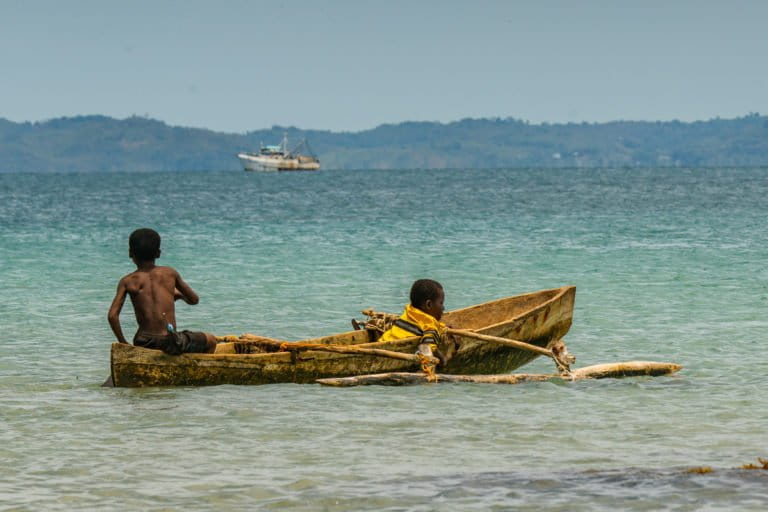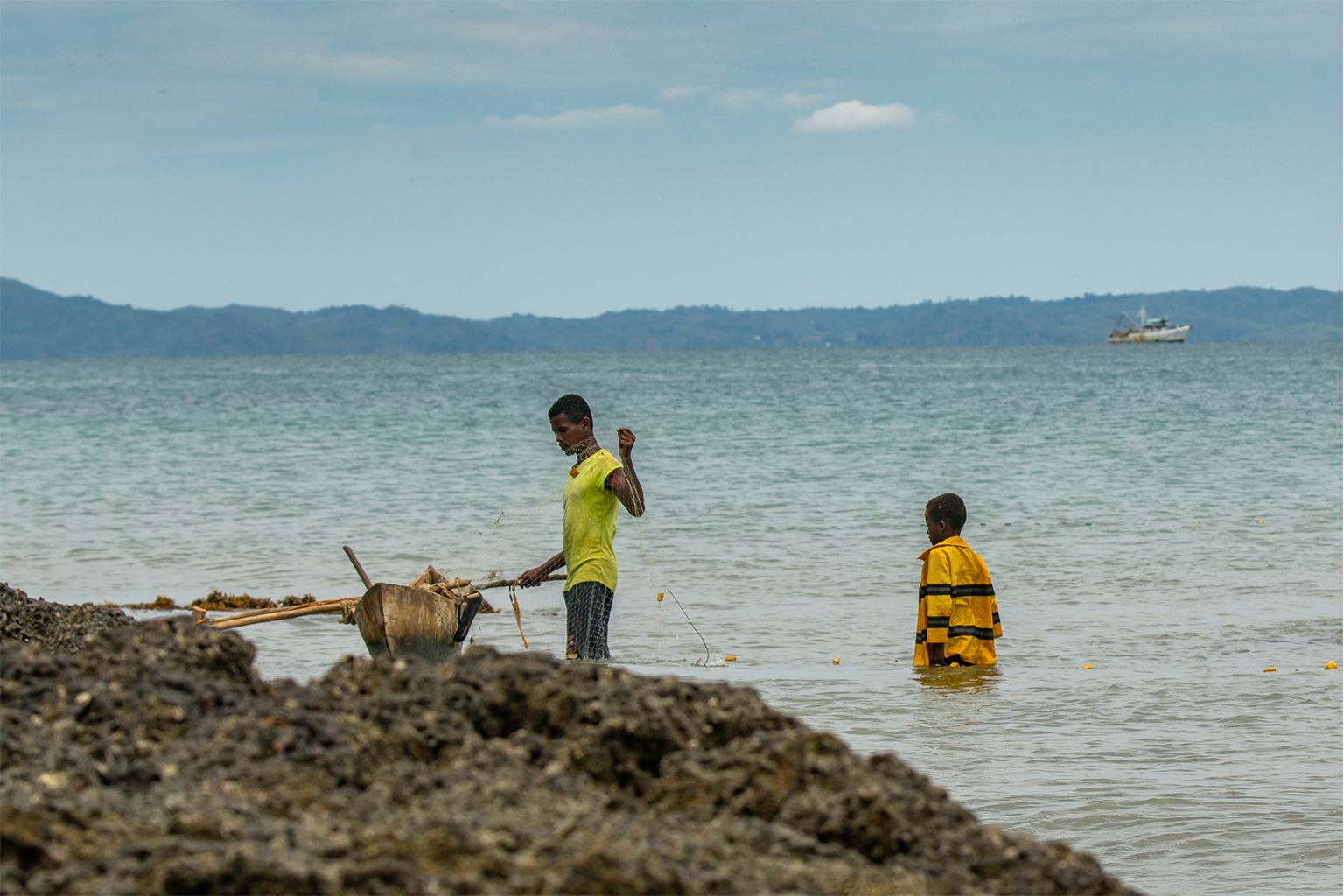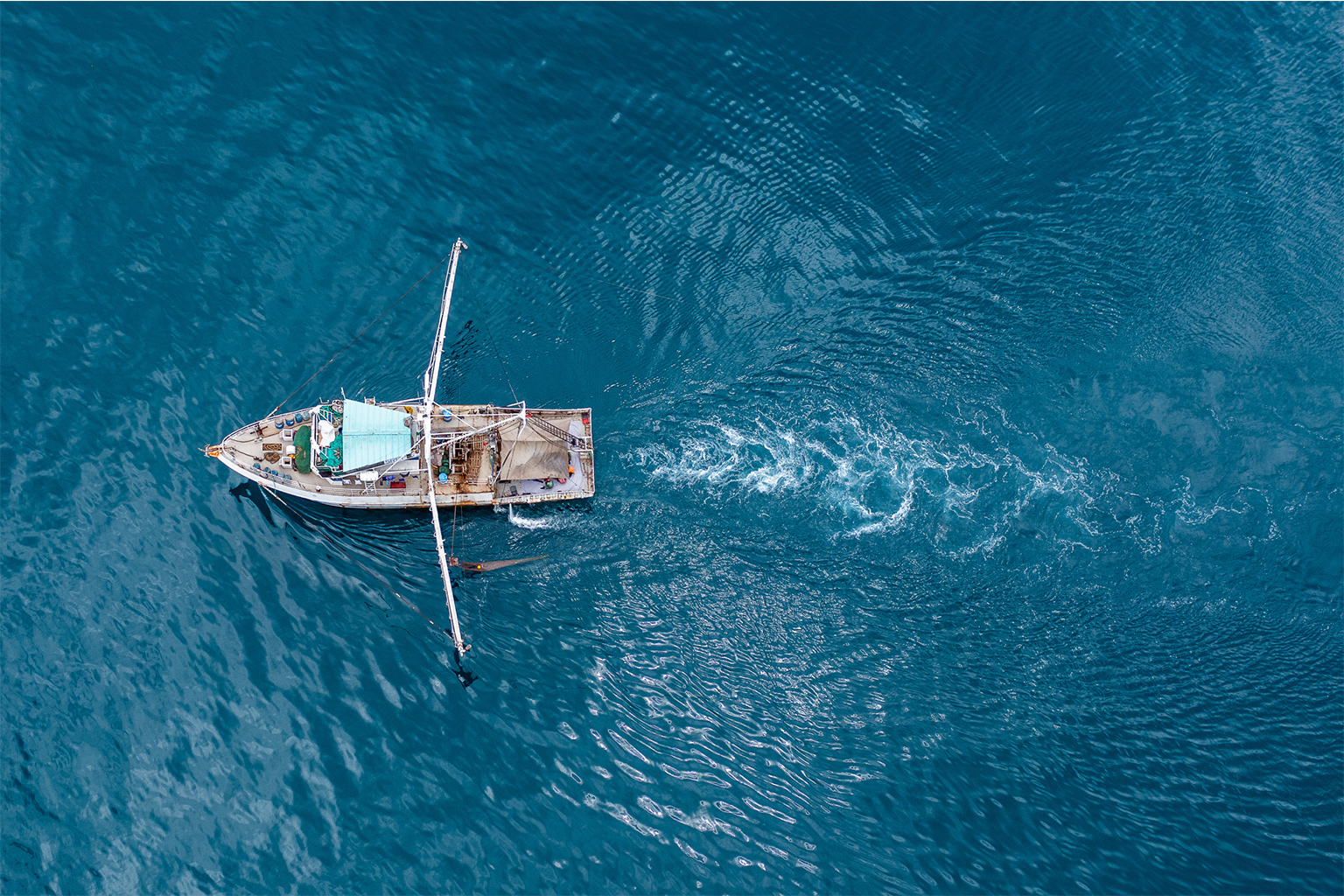
- Madagascar’s auction for nearshore trawling licenses has elicited concern from civil society members, who say it was not conducted transparently and opens the door for environmental mismanagement.
- Two Chinese-backed firms won nearly half of the fishing licenses. One of them has brought in vessels that were caught fishing illegally in West Africa last year, and the other, which was already fishing in Madagascar, may have violated a national fishing regulation this year.
- But observers have also welcomed other aspects of Madagascar’s fisheries management overhaul this year.
- These include the creation of the Ministry of Fisheries and the Blue Economy, the appointment of scientist and civil society member as the new minister and the joining of FiTI, a global fisheries transparency initiative.
This is part three of a three-article series on industrial fishing in Madagascar’s waters. Part one looked at offshore fishing; part two focused on a new exclusive-access zone for small-scale fishers.
Earlier this year, there was an unusual stoppage: in March and April, normally the heart of Madagascar’s shrimp fishing season, the nation’s trawlers remained at port. For the first time in decades, the government was shaking things up. It reopened the bidding for the right to trawl nearshore waters for shrimp and other seafood. Nominally, the companies vying for licenses were Malagasy, but most had foreign parent companies.
The tendering process raised a number of concerns among conservationists and civil society members. It brought an end to a management system seen as moderately effective, and it was not transparent or inclusive of small-scale fishers. The results were not publicly announced, but once leaked, they caused more concern. Two Chinese-backed firms won nearly half of the fishing licenses, and one of them brought in vessels that were caught fishing illegally in West Africa last year.
Civil society members said they don’t object to Chinese operations in Madagascar per se. But they said they worry that Madagascar’s pivot toward China, also evident in its offshore fisheries, indicates a lack of commitment to sustainability and transparency on the part of the government. China’s distant-water fleets are notorious for engaging in illegal and unsustainable fishing, often enabled by large government subsidies.
The new management system comes amid a flurry of other changes in Madagascar’s fisheries sector, some of which conservationists have applauded, such as the appointment of a leading civil society member as minister of fisheries. It’s an especially high-stakes period for the country, with a more equitable, sustainable and transparent fishing sector within reach, but no guarantees that it will be achieved, Ketakandriana Rafitoson, executive director of Transparency International–Initiative Madagascar, told Mongabay.

Change afoot
In April, the government issued a call for offers, with five-year nearshore fishing licenses for sale, each of which allows a vessel to collect up to about 90 metric tons of shrimp per year in a certain zone. This was the first major change since 2000, when the government issued 20-year licenses.
The shake-up caused concern among conservationists, who believed the old system, based on an Australian model, gave trawling firms an incentive to manage the fishery well. Although management had been technocratic, with small-scale fishers given little voice, conservationists regarded it as somewhat effective, with, for example, the industry scaling back activity as catch declined. In recent years, only about 40 industrial vessels operated in Madagascar’s coastal waters, compared to about 75 two decades ago (100 counting semi-industrial trawlers, which no longer operate). Consequently, industrial vessels’ catch per unit of effort stabilized, an indication that target species’ populations largely had, too, albeit at a low level. Eric Douhéret, chief operating officer of Groupe Réfrigépêche Madagascar, a long-standing Madagascar-based, French-owned trawling firm, called the management system of the last two decades “exemplary and virtuous” in an email to Mongabay.
Moreover, this year, the government auctioned off 50 licenses — up from the roughly 40 of recent years — creating the potential for expanded industrial fishing effort, which would add pressure on ecosystems and fish populations. However, not all of the 50 licenses were used this year, and the season started late, so any increase in effort has yet to materialize.
The government did not handle the tendering process in a transparent and inclusive way, civil society members told Mongabay. Guénolé Ravelomahafaly, communications manager of Mihari, a network of small-scale fishers’ groups and supporting NGOs, told Mongabay that he was “very surprised” to first learn about the tendering process in the newspaper. Two other groups called for reforms, including that officials publish a list of criteria they would use in selecting companies, which the government did not immediately adopt.
A government “call for proposals” document circulated privately to fishing companies alongside the public call for offers also caused civil society members concern once they obtained it: it indicated that licensing fees could be paid in cash, a practice that can enable corruption, as cash transactions can be difficult to trace.

A new big fish?
The license sale precipitated a partial shake-up in the cast of companies fishing Madagascar’s inshore waters. For decades, the sector has been dominated by the Groupement des Aquaculteurs et Pêcheurs de Crevettes à Madagascar (GAPCM), an industry group comprised of a handful of trawling firms that are registered in Madagascar and backed by foreign capital. Some member firms, such as Pêcheries de Nossi Be, a firm owned by Unima, whose owners were the subject of a Panama Papers investigation, have trawled Madagascar’s coasts for half a century. Many of the GAPCM firms — the old guard — won new contracts in the April sale and began fishing again on May 10, after missing out on March and April fishing.
However, there was one newcomer and it won eight licenses: Mada Fishery, a company with ties to China. It now possesses fishing rights along parts of the center-west and southwest coast through 2025. Its vessels did not fish this year but could begin trawling when the 2022 season opens in March.
Three of the eight vessels — Gorde 105, Gorde 106 and Gorde 107 — have a troubling recent history. Authorities in the Gambia arrested them for fishing illegally inside an exclusive-access zone for artisanal fishers in November 2020. Two of the three were “double-bagging” their nets to reduce selectivity, in violation of Gambian regulations.
The eight vessels’ journey to Madagascar also drew scrutiny. Authorities in the Seychelles detained the vessels for several days in May for holding suspicious paperwork after they anchored in the country’s waters without permission. Four vessels lacked proper identification, according to a news report. Once released, the vessels went to Toamasina, a port city on Madagascar’s east coast, where they remained docked for much of the year.

Just who is running and profiting from Mada Fishery is difficult to discern. Mada Fishery’s ownership structure is less transparent than those of the GAPCM firms, introducing a new level of opacity to the sector. The company is registered to a Toamasina address, having formed in January 2021 with about $50,000 in capital, a local registration record shows. Mongabay was unable to obtain contact information for Mada Fishery, and the fisheries ministry declined to share any information about the company.
All eight Mada Fishery vessels have been registered to Chinese ports or companies in the recent past. Four Gorde vessels, including the three mentioned above, were registered to the port of Shidao in northeastern China, according to data obtained by Mongabay.
The four other Mada Fishery vessels, Lu Qing Xin Yuang Yu 005 through 008, are owned by Qingdao Kaihang Fisheries Co Ltd. (QKF), a company based in the city of Qingdao in China’s Shandong province, according to company records obtained by C4ADS, a Washington, D.C.-based nonprofit that built Triton, a fisheries transparency platform. QKF is wholly owned by Changhai County Kaijun Aquatic Products Co., Ltd., a company based in Dalian, China, the records show. QKF did not respond to requests for comment, including about whether it owns Mada Fishery or its eight vessels.
Ultimately, the relationship between QKF and Mada Fishery remains unclear, replicating a pattern that is common in the global industrial fishing sector, in which complex networks of related companies obfuscate the identity of their ultimate owners and make it difficult for authorities or watchdogs to hold owners accountable in the event of bad behavior.


Another Chinese firm with a questionable recent record
Even before Mada Fishery’s arrival on the scene, Chinese-owned vessels had been trawling Madagascar’s waters for more than a decade. China National Fisheries Company Overseas Fishing Co., a state-owned Chinese firm, has had a majority stake in Somapeche, a GAPCM member, since 2009. Somapeche won 14 fishing licenses in this year’s tendering process, the most of any firm (tied with Groupe Réfrigépêche Madagascar).
In recent months, Somapeche vessels have repeatedly fished within 2 nautical miles (3.7 kilometers) of the west coast, in apparent violation of a new regulation designed to create an exclusive-access zone for small-scale fishers, according to data from Global Fishing Watch, a nonprofit vessel tracking platform. At least eight Somapeche vessels appear to have violated the rule, more than any other trawling firm, the data indicate. Most of these eight vessels have also incorrectly reported their automatic identification system (AIS) positions, making it look as if they are in the Southern Ocean, near Antarctica — a practice known as spoofing that can be accidental but that vessels often deploy intentionally to disguise illegal activities.
Two Malagasy employees of Somapeche told Mongabay that the company’s working conditions were harsh, with extremely long working hours. They said the pay, which depends in part on the amount of catch, wasn’t commensurate: usually 500,000 ariary (about $125) per month, though sometimes up to double that.
“The salary we get is not in line with the fact that we work 24 hours a day or with the catch we get,” one of the employees told Mongabay, saying his salary hadn’t increased since 2015 and he’s struggled to pay school fees for his children. “Our salary isn’t enough to live on … I feel as if I’m working for nothing,” he added.
Somapeche, which has 1,200 employees and is based in the city of Mahajanga, exports shrimp to western Europe and other high-income markets under the brand name “Fresh Frozen Shrimp, Product of Madagascar,” according to a credit report.
China National Fisheries Company Overseas Fishing Co. owns more than 75% of Somapeche and is itself wholly owned by China National Agricultural Development Group Corporation (CNADC), a state-owned company based in Beijing. Somapeche and the China National Fisheries Company Overseas Fishing Co. didn’t respond to requests for comment for this article.

A little help from two governments
With less catch per unit of effort than in decades past, trawling Madagascar’s waters doesn’t appear to yield the commercial windfall that it once did. Some firms have pivoted resources toward shrimp aquaculture. So what keeps the trawlers at sea? The answer is difficult to know, as financial records for Madagascar’s trawling firms are not public. However, there’s evidence that government support improves trawling profits.
Fuel is a major cost for industrial fishing companies, and fuel price affects the amount of fishing they do; this is especially true for trawlers, as towing gear requires extra energy. Countries around the world subsidize fishing companies’ fuel, and Madagascar is no exception. Trawlers licensed to fish there pay only the offshore cost of fuel and aren’t subject to fuel taxes and royalties, according to a representative of the fisheries ministry’s economic observatory, responding to emailed questions from Mongabay. These taxes and royalties make up about one-quarter of the price at the pump for diesel, according to the website of Madagascar’s petroleum regulator and a 2019 World Bank report.
Madagascar’s government isn’t the only one helping: Somapeche has received subsidies from the Chinese government. A 2014 company asset assessment report shows that Somapeche was not only receiving fuel subsidies at the time but was projected to receive more than $2.5 million per year from 2014 to 2020. It’s not clear if the projections were realized, as China has made its subsidies less transparent since 2014. China no longer publicly tracks fuel subsidies to distant-water fleets, according to new findings from Oceana, a Washington, D.C.-based marine conservation NGO.
Neither is it clear if Somapeche currently receives subsidies from the Chinese state. But its parent company, China National Fisheries Corporation Overseas Fishery Co., does receive significant subsidies. Internationally, countries have been hashing out an agreement aimed at ending “harmful” fishing subsidies under the auspices of the World Trade Organization, but progress has been slow. China tops the list as the world’s most prolific subsidizer of fisheries.
“These subsidies give Chinese vessels an unfair advantage over small-scale fishers,” Tess Geers, a senior research manager at Oceana, told Mongabay in an email. Without government help, much industrial fishing wouldn’t be profitable, she said. “Subsidies can drive overexploitation because they mask declining profitability.”

A new hope
2021 has been a mixed year for civil society observers of Madagascar’s fisheries sector. While they have criticized some government moves, they have praised others.
Most notably, the government established the exclusive-access zone for small-scale fishers. Although adherence to the rule appears spotty, experts consider it an important regulatory building block. The Mihari fishers’ network commended the decree in a press release, and Ravelomahafaly, the group’s communications manager, told Mongabay that it was a big step forward.
“I think the government did this because they are more conscious about the importance of local people,” he said, referring to small-scale fishers. Mihari has advocated for such a zone for several years.
Ravelomahafaly and other civil society members also supported another recent change: the government set up a new Ministry of Fisheries and the Blue Economy in August, disbanding the Ministry of Agriculture, Livestock and Fisheries that had handled fisheries issues for the previous two and a half years. Moreover, the government named Paubert Mahatante, a scientist and leader of the Southern African Regional Non-State Platform in Fisheries and Aquaculture, a civil society group, as head of the new ministry — a rare instance of a civil society member gaining a seat in Madagascar’s cabinet.

Not long after Mahatante took office, Madagascar joined FiTI, a global fisheries transparency initiative, earning applause from conservation NGOs. If Madagascar completes the process, the government will have to publicly disclose its fisheries agreements — a long-standing demand of civil society groups, which have criticized a lack of transparency in the sector.
The Ministry of Agriculture, Livestock and Fisheries did not respond to requests for comment about the license-tendering process from Mongabay earlier this year, and Mahatante, the current fisheries minister, declined to comment on his predecessor’s decisions. Mahatante also declined to comment on the details of plans to disclose fisheries agreements. He said the government was committed to improving fisheries management and would follow the FiTI process.
Banner image: Young fishers set a net close to shore on Nosy Faly as an industrial trawler fishes further offshore. Image by Mongabay.
Sheryl Lee Tian Tong, a Mongabay staff writer based in Singapore, contributed reporting for this article.
FEEDBACK: Use this form to send a message to the editor of this post. If you want to post a public comment, you can do that at the bottom of the page.
Changes to Madagascar’s trawling sector raise questions and hopes
Source: Trends News

0 Comments